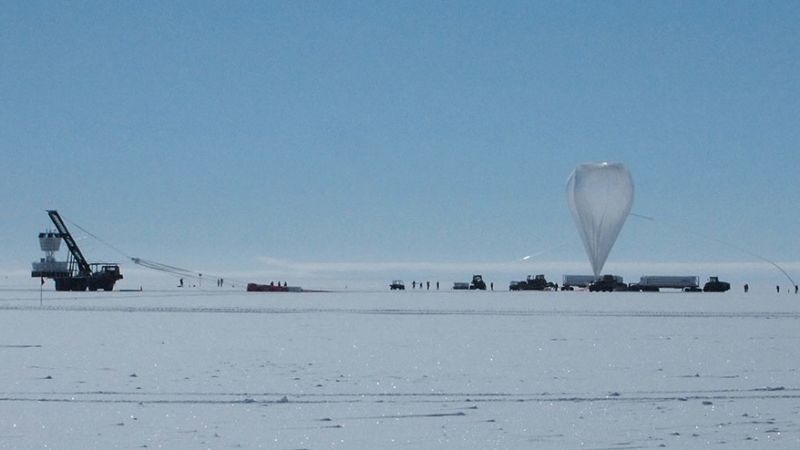In a recent scientific endeavor, researchers are working diligently to uncover the elusive identity of strange signals detected beneath the icy terrain of Antarctica. This mystery has persisted for over a decade, compelling scientists to investigate and analyze these anomalous signals, which have piqued the interest of many in the scientific community.
The peculiar radio waves were discovered while scientists sought to uncover information about high-energy cosmic particles known as neutrinos. Neutrinos are often referred to as “ghost particles” due to their extremely low mass and their ability to pass through virtually any form of matter without being altered. These particles travel across the universe and reach Earth, offering clues about cosmic phenomena that are still poorly understood.
Over the last ten years, a number of experiments have been conducted in vast volumes of water and ice to locate neutrinos, which are believed to hold key insights into cosmic rays—the most energetic particles observed in the universe. Notably, NASA’s Antarctic Impulsive Transient Antenna (ANITA) project played a significant role in this endeavor. Between 2006 and 2016, ANITA employed balloons equipped with cutting-edge instruments to survey Antarctica for evidence of these elusive neutrinos.
During this extensive search, the ANITA team encountered an unexpected phenomenon: anomalous radio waves that did not conform to the expected signatures of neutrinos. Instead, these signals appeared to emanate from beneath the Earth’s crust, having traversed thousands of miles of rock. This posed a perplexing challenge, as the assumption in particle physics is that radio waves should be absorbed by such dense material. The research team found these signals to be inconsistent with existing scientific knowledge, leading to a renewed quest for answers.
Despite follow-up studies aimed at identifying these signals, including analyses conducted by the Pierre Auger Observatory in Argentina, researchers have yet to replicate the findings of the ANITA experiment. In March, their results were published in the journal Physical Review Letters, indicating that the original anomalous signals remain unexplained. According to Stephanie Wissel, an associate professor of physics and one of the study’s coauthors at Pennsylvania State University, this uncertainty does not necessarily suggest the presence of new physics; rather, it invites further exploration of the topic.
Looking ahead, scientists believe that more sensitive detection equipment could provide the necessary insights to solve this intriguing puzzle or confirm whether the original signals were mere statistical anomalies. Neutrinos play a pivotal role in tracing cosmic events, primarily originating from cosmic rays that collide with Earth’s atmosphere. Cosmic rays are composed primarily of protons and atomic nuclei, and they are propelled across the universe by cosmic accelerators that exceed the performance capabilities of current detectors like the Large Hadron Collider.
Despite the challenges of locating neutrinos due to their unique properties, such as their ability to travel through solid matter with minimal interaction, ANITA was conceived specifically to detect high-energy neutrinos using Antarctica’s ice as a medium. The project capitalized on the principle that a neutrino colliding with an atom in the ice could produce detectible radio waves, which would permit a comprehensive analysis of cosmic events that generate these ghostly particles.
During its operational flights, ANITA recorded several instances of high-energy cosmic-ray showers, characterized by bursts of particles behaving in unforeseen patterns. This has raised questions about the origin of various signals and their respective trajectories. According to Justin Vandenbroucke, an associate professor of physics at the University of Wisconsin, the unexpected steep angles of the signals further complicate the ability to trace their sources.
The researchers involved in this exploration did not stop at ANITA’s findings; the Pierre Auger Collaboration took it upon themselves to examine over a decade’s worth of data in pursuit of understanding these signals. Their methodology employs a hybrid detection mechanism to study cosmic rays, involving both ground-level tanks that capture high-energy particles and tracking ultraviolet interactions within Earth’s atmosphere. Peter Gorham, the original designer of the ANITA experiment, emphasized the need for robust computer simulations to uncover any patterns that could shed light on the anomalous signals.
While the scientific community grapples with the uncharted territory represented by the ANITA signals, upcoming projects like the Payload for Ultra-High Energy Observations (PUEO) are set to extend further into the investigation. Scheduled to fly over Antarctica in December, PUEO promises enhanced sensitivity that may illuminate the nature of these long-standing anomalies, possibly leading to a breakthrough in our understanding.
As this scientific drama unfolds, Wissel expressed her excitement about the potential insights PUEO could bring. Finally tackling what has long been categorized as a mystery, she stated, “Right now, it’s one of these long-standing mysteries. I’m excited that when we fly PUEO, we’ll have better sensitivity.” The quest for answers continues, illustrating not just the complexities of cosmic physics but also the relentless pursuit of knowledge by dedicated scientists across the globe.



